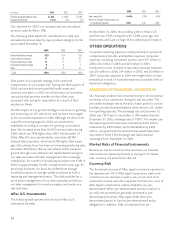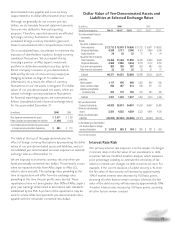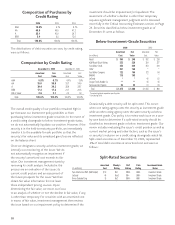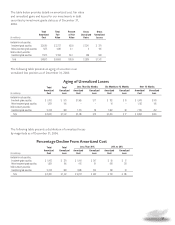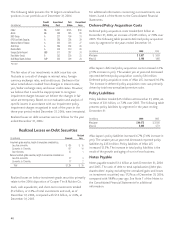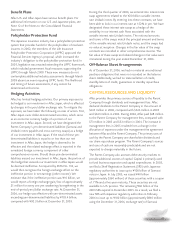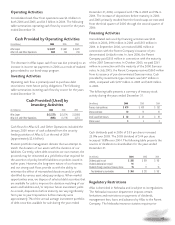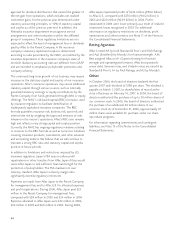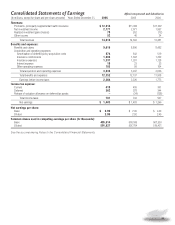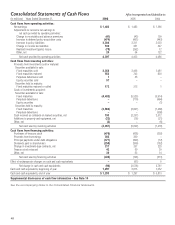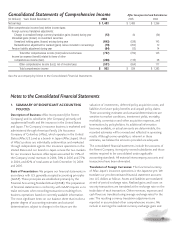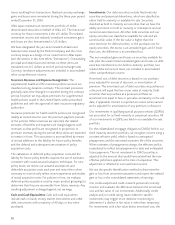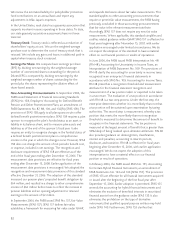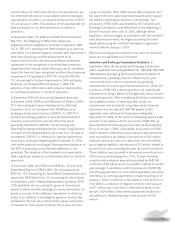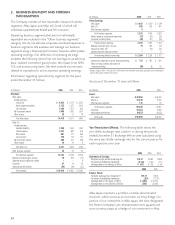Aflac 2006 Annual Report Download - page 48
Download and view the complete annual report
Please find page 48 of the 2006 Aflac annual report below. You can navigate through the pages in the report by either clicking on the pages listed below, or by using the keyword search tool below to find specific information within the annual report.
44
approval for dividend distributions that exceed the greater of
the net gain from operations, which excludes net realized
investment gains, for the previous year determined under
statutory accounting principles, or 10% of statutory capital
and surplus as of the previous year-end. In addition, the
Nebraska insurance department must approve service
arrangements and other transactions within the affiliated
group of companies. These regulatory limitations are not
expected to affect the level of management fees or dividends
paid by Aflac to the Parent Company. A life insurance
company’s statutory capital and surplus is determined
according to rules prescribed by the NAIC, as modified by the
insurance department in the insurance company’s state of
domicile. Statutory accounting rules are different from GAAP
and are intended to emphasize policyholder protection and
company solvency.
The continued long-term growth of our business may require
increases in the statutory capital and surplus of our insurance
operations. Aflac’s insurance operations may secure additional
statutory capital through various sources, such as internally
generated statutory earnings or equity contributions by the
Parent Company from funds generated through debt or equity
offerings. The NAIC’s risk-based capital (RBC) formula is used
by insurance regulators to facilitate identification of
inadequately capitalized insurance companies. The RBC
formula quantifies insurance risk, business risk, asset risk and
interest rate risk by weighing the types and mixtures of risks
inherent in the insurer’s operations. Aflac’s RBC ratio remains
high and reflects a very strong capital and surplus position.
Currently, the NAIC has ongoing regulatory initiatives relating
to revisions to the RBC formula as well as numerous initiatives
covering insurance products, investments, and other actuarial
and accounting matters. We believe that we will continue to
maintain a strong RBC ratio and statutory capital and surplus
position in future periods.
In addition to limitations and restrictions imposed by U.S.
insurance regulators, Japan’s FSA may not allow profit
repatriations or other transfers from Aflac Japan if they would
cause Aflac Japan to lack sufficient financial strength for the
protection of policyholders. The FSA maintains its own
solvency standard. Aflac Japan’s solvency margin ratio
significantly exceeds regulatory minimums.
Payments are made from Aflac Japan to the Parent Company
for management fees and to Aflac U.S. for allocated expenses
and profit repatriations. During 2006, Aflac Japan paid $25
million to the Parent Company for management fees,
compared with $28 million in 2005 and $24 million in 2004.
Expenses allocated to Aflac Japan were $32 million in 2006,
$30 million in 2005 and $26 million in 2004. During 2006,
Aflac Japan repatriated profits of $442 million (¥50.0 billion)
to Aflac U.S., compared with $374 million (¥41.2 billion) in
2005 and $220 million (¥23.9 billion) in 2004. Profits
repatriated in 2004 were lower primarily as a result of realized
investment losses recognized in 2003. For additional
information on regulatory restrictions on dividends, profit
repatriations and other transfers, see Note 11 of the Notes to
the Consolidated Financial Statements.
Rating Agencies
Aflac is rated AA by both Standard & Poor’s and Fitch Ratings
and Aa2 (Excellent) by Moody’s for financial strength. A.M.
Best assigned Aflac an A+ (Superior) rating for financial
strength and operating performance. Aflac Incorporated’s
senior debt, Samurai notes, and Uridashi notes are rated A by
Standard & Poor’s, A+ by Fitch Ratings, and A2 by Moody’s.
Other
In October 2006, the board of directors declared the first
quarter 2007 cash dividend of $.185 per share. The dividend is
payable on March 1, 2007, to shareholders of record at the
close of business on February 16, 2007. In 2004, the board of
directors authorized the purchase of up to 30 million shares of
our common stock. In 2006, the board of directors authorized
the purchase of an additional 30 million shares of our
common stock. As of December 31, 2006, approximately 37
million shares were available for purchase under our share
repurchase programs.
For information regarding commitments and contingent
liabilities, see Note 13 of the Notes to the Consolidated
Financial Statements.


